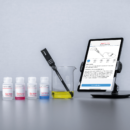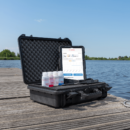ISFET pH probe support: expert solutions
Please check whether your question is mentioned below. More general FAQ’s are listed at our homepage.
If your question is not listed, do not hesitate to ask your question via info@sentron.nl . We’ll come back to you as soon as possible.
Do you have some operation tips?
Yes, we have!
- Clean your probe regularly during use.
- Make sure that the medium which is being measured, is in contact with the ISFET (which is the metallic spot at the probe tip) and the diaphragm (which is the white surface on the probe tip) simultaneously.
- When using the probe in dry soil, prepare a pilot hole with the predrill stick and insert some demineralized water. Then rotate left and right several times and tilt to ensure sample contact.
- When testing in direct sunlight or on a bright reflecting surface, please use brown, opaque or shielded sample containers. Very bright light might influence the performance of the sensor.
Do you have movies how to use the wireless probe?
Yes, we have. See our help for several movies on the use of the probe:
- Unpack the box and get started
- Replacement of Sentron ConeFET pH sensor part by MicroFET pH sensor part
- Connection and calibration of the Sentron ISFET pH probe
- pH monitoring with the Sentron ISFET pH probe
- Sentron CupFET pH probe: the ISFET pH probe for small volume pH monitoring
- Sentron ISFET pH probe for outdoor pH monitoring
My pH probe is failing. What should I do?
It could well be that the probe is not cleaned properly. Please check the cleaning procedure and revitalization options in the ‘wireless pH probe manual’.
Probe wear is another cause for probe failure. Probe wear is often, but not necessarily, preceded by a period of declining calibration slope values. Probe wear is dependent on how the probe is used, stored. Worn probes need to be replaced.
For pH 16 readings, it means that the probe is not measuring pH. Most likely the tip is not in the (liquid) sample. Make sure the sensor and the reference electrode are in contact with the sample.
Do I need to clean the probe after use?
Yes! Proper maintenance of a probe is important. The probe should be cleaned properly and regularly. If not, probe malfunction can occur due to a polluted diaphragm or ISFET. The cause for this pollution is usually the sample.
Pollution on, or blockage of, the sensor and reference electrode diaphragm surface is the most likely cause for probe failure. Take action when any of the following events occur: low slope, drift, instability of the reading, slow calibration, probe will not calibrate, etc. In these events the pH value doesn’t change as expected when changing samples. The action to take is to start the cleaning procedure and perform a revitalization. These are described in the ‘wireless pH probe manual’.
How do I clean my probe after use?
The appropriate cleaning frequency is dependent on the type of sample being measured. A good rule of thumb to use when sampling colored liquids is when the reference diaphragm is no longer white, the probe should be cleaned.
The cleaning procedure is described in the ‘wireless pH probe manual’.
What do the LED color codes at the probe mean?
The LED of the wireless probe is either off, green, or blue in normal situations. The color codes are described in the ‘wireless pH probe manual’.
The LED is purple in case of reset. The on/off sign on the head side of the probe is used for a reset of the probe. If you do not want to reset the probe, take off your finger immediately when the LED turns purple.
When something is wrong in the Sentron app or with the probe itself, the LED of the probe will turn orange. This is the case when for example the probe needs to be calibrated. When you have tried the suggestions in the app without success, please contact the support@sentron.nl.
What number of calibration points do I need?
The more points are taken for calibration, the more accurate the pH reading is. Hence, the more decimals are used for the pH value. There is 1 decimal in the pH reading for the 1-point calibrated pH probe, 2 decimals for the 2- or 3-point calibrated probe, and 3 decimals for the 5-point calibrated pH probe.
How often should I calibrate my pH sensor?
The calibration interval needed for the pH probes is highly dependent on the application. The more uniform process conditions are (temperature, pressure, composition, pH fluctuation, etc.), the more stable a pH sensor will be and the longer the calibration interval may be.
Most pH installations calibrate between once a week and once a month but shorter or longer intervals may be appropriate based on experience. It is a good practice to begin by calibrating frequently and then gradually go to longer intervals, as stability in the installation and accuracy requirements allow.
NB the Sentron app shows a notice by default 24 hours after calibration. The number of decimals is reduced to 1 until the new (multipoint) calibration is performed.
I purchased one of your products and need support. What to do?
Please check the section Delivery and Returns at Terms and Conditions for our policy on return goods. If you cannot find your answer, do not hesitate to refer to support@sentron.nl for any issues regarding the use of your purchased products.
You might need support on the obsolete SI400 or SI600 pH meter. In this case we’ll guide you through the best approach to either get the product repaired or to switch to our new pH product line. The new pH product line are the wireless probes that are to be used with the free Sentron app at your mobile phone or tablet.
What mobile device can be used for the wireless probes and application?
Each mobile device, smartphone, tablet, iPad, using iOS or Android can be used to download and install the Sentron application. The only requirement for the mobile device is Bluetooth version 5.0 or higher.
For your convenience we do offer suitable mobile phones and tablets in our webshop.
How about the data privacy ?
Sentron does not collect any data from the user when using the Sentron app.
See also our Privacy Policy.
What is the maximum distance between the mobile phone and the probe?
The connection between the probe and the mobile phone is dependent on the Bluetooth signal. We have used a powerful approach for this, enabling a distance of maximum 50 meters through the air.
Do I need to have the mobile device in reach of the probe at all times?
No, for the interval measurement it is not required. Once the interval measurement has started, it will continue even when your mobile device is out of Bluetooth range of the probe. Data will be stored in the probe and downloaded to the app as soon as your mobile device is in reach of the probe. One interval can have up to 10,000 readings.
The value of the pH is 16. What does that mean?
For pH 16 readings, it means that the probe is not measuring pH. Most likely the tip is not in the (liquid) sample.
Make sure the sensor and the reference electrode are in contact with the sample. Make sure that the sample is at least a bit moisture such that hydrogen ions can make a bridge between the reference and the ISFET sensor.
Can I revitalize my probe?
Yes. Revitalization is performed to regenerate the diaphragm of the reference electrode in the pH probe. The diaphragm is part of the so called reference electrode and necessary for pH measurements.
The revitalization procedure is described in the ‘wireless pH probe manual’.
What is the best way to store my probe?
For short time periods (≤ 2 days) probes can be best stored ‘wet’ in a beaker with pH7. For longer time periods (>2 days) the probe can be best stored ‘dry’ in the shipping box. The full storage procedure is described in the ‘wireless pH probe manual’.
I cannot find how to turn off the probe?
The wireless probe cannot be turned off. When it is not measuring, it will be in the standby mode. The LED is off in this situation.
To reactivate the probe, please tap the on/off sign at the head side of the probe.
What are the advantages of Sentron pH buffer?
The Sentron buffers are delivered in twin neck bottles.
- No need for a separate container(s) when calibrating an electrode. Calibrate directly in the (small) dispensing chamber.
- No possibility of contamination between the dispensing chamber and the main repository
- No waste: the dispensing chamber can hold the correct amount of buffer solution for various probe types
- If desired, a separate container or a larger amount of buffer solution can be used by accessing the main repository directly
- Easy to carry and dispense, ideally suited for field work but also convenient for table-top and laboratory use
Note
- Always use fresh and uncontaminated buffer when performing a calibration.
- Buffers can be polluted due to exposure to open-air or (UV)light. Reclose the cap on the bottle as soon as possible.
- Do not use the buffer solution in the dispensing chamber after more than 15 minutes.
What determines the lifetime of your pH sensor?
The ISFET pH sensor can have very long life as long as it is not broken, scratched or chemically attacked. The pH sensor probes include a reference chamber with AgCl electrode and a finite amount of electrolyte KCL. The electrolyte must maintain consistent electrical contact with the process sample to allow measurement. Because of this contact, through the porous diaphragm, it is subject to gradual dissolving and loss in the sample, although this is retarded by a thick gelling agent.
The reference electrode life is highly application dependent. It can be weeks to years depending on temperature and pressure cycling which expand and contract the electrolyte, tending to “pump” it out of the chamber. In dirty samples the reference junction is also subject to coating and contamination.
What determines the shelf life of the pH probes?
The shelf life of the pH probe is dependent on the storage conditions. Best storage is at normal room temperature with its original storage cap and solution in place on the end of the electrode. The pH probe can easily be revived after a long storage.
I did not use my pH probe for more than 3 months. Can I revive my probe?
In case the device has not been used for more than 3 months, a longer revitalization is recommended. Follow the steps of the revitalization (see above) except for 20 hours instead of 20 minute ‘cold’ KCl-dip. After that, flush off any crystals from the probe tip with demineralized water.





